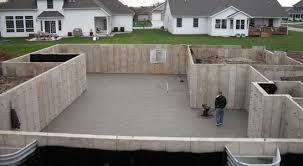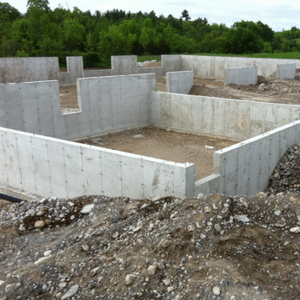How Is A Foundation Built?
A house needs a foundation to carry its considerable weight, to provide a flat and level base for construction, and to separate wood-based materials from contact with the ground, which would cause them to rot and cause termite infestation.
Depending on when and where a house has been built, the foundation may be made of stone, brick, preservative-treated lum0ber, concrete block, or poured concrete. Concrete is by far the most common material for foundations.
Most of the houses have a raised perimeter foundation that supports floors and load-bearing walls. Some of them are built on a flat, concrete slab, which provides a base for the structure and serves as the bottom floor of the house. Others, especially holiday homes as well as small, old houses, often rest on a series of concrete piers.
There are three main foundation types: full basement, crawlspace and slab-on grade. Different types are popular in different parts of the country, with reasons that include ground conditions and local market expectations.
Full Basement
Although full basements can be found in many areas, they tend to be expected by homeowners in the Northeast. A full basement usually consists of basements placed deep below the frost depth of the region and eight-foot-high walls enclosing a four-inch-thick concrete slab. This creates an underground room that can be used as a storage and mechanical space and/or as a living area.
Basement finishing is a growing trend: homeowners turn these spaces into recreation rooms, gyms and entertainment centers. If the lot slopes or allows a walkout configuration, the basement will have natural light, good ventilation and a more spacious feel. If you think you might want to put a toilet in the basement, consider including a grinder pump.
If you’re planning to finish the basement, you might want to consider installing rigid foam insulation under the slab. Although it may not significantly reduce the use of energy, it could make the space more comfortable. Even when the basement is not finished, the insulation of the slab and walls can reduce mold and mildew problems, as the insulation reduces the chance of condensation by keeping the concrete at a higher temperature.
Crawlspace Foundations
Crawlspaces are the most common in the Southeast and the Midwest. The feet are placed below the frost line, but there’s only enough headroom between the floor and the floor frame for someone to crawl around.
Most of the crawlspaces include the opening of the foundation vent. They are supposed to prevent the build-up of excess moisture, but in practice they often backfire by bringing moisture into space. “Open gateways can become breeding grounds for mold and moisture,” says Brian Coble, who directs the High Performance Homes program at Advanced Energy, a North Carolina-based science research firm. “This moisture can soak the frame of the home, lead to rot and structural failure, and can carry mold spores and other pollutants into the living space of the home.”
Building scientists like Coble now recommend sealing and isolating the ramp and covering the ground with a polyethylene vapor barrier, or even a concrete slab. These details add costs, but a multiple home-field study (27 homes in different parts of the country) by Advanced Energy has confirmed that they can also lower space-conditioning bills and reduce mold and mildew. You end up with a tempered, dry storage space as a bonus. If enough headroom is available, the heating unit can also be placed there, freeing up space in the house.
Slab-On-Grade
The slab-on – grade foundation is just what it sounds like: a concrete slab poured at the grade level that serves as a subfloor for the main living area of the home. A shallow base around the edges of the slab transfers the weight of the walls of the house to the ground. Before pouring, a bed of gravel is spread across the slab area to allow drainage, wire mesh is rolled out to reduce the chance of cracking and any in-slab plumbing pipes or electrical conduits are installed.
Slab foundations are most common in warm regions and high water tables, such as Florida. When used in northern climates, special frost proofing details are required, which, in most cases, consist of a short foundation wall (called a “stemwall”) poured under the frost line. Putting a layer of rigid foam under a slab in a slab-on – grade home is also a good idea in the North and absolutely necessary if the slab is to have built-in hydronic heat.
Note that the use of a foundation type that is not common in your area may affect the schedule and budget. For example, with a slab, the mechanical systems have to be completely worked out before the slab is poured, so that the proper elements are put in place. If this is not the standard practice where you live, subcontractors may raise prices to cover unexpected time and cost overruns.



Are You Looking for a Concrete Foundation Specialist You Can Trust?
Spaulding Concrete has been laying concrete foundations throughout the San Francisco Bay Area for over thirty years. We have poured hundreds upon hundreds of foundations for homes, commercial and agricultural properties over the years. The more difficult a project is, the harder we work to provide real solutions and state-of-the-art solutions. We partner with each client from concept to completion, which enables us to design and implement plans that meet or exceed our client’s goals. Our concrete design team is made up of highly skilled, experienced estimators and craftsmen who work diligently to minimize problems and ensure that we remain on schedule. With all the resources available to complete your project through strong connections with leading suppliers, we are a single source for any type of concrete foundations. For all our products and services, we use the latest industry technologies so you can ensure your project will be completed on-time and under code. When it’s time to finish and place, you can count on our highly experienced crews who are skilled in all facets of the industry. Spaulding Concrete will deliver if you need experience with any type of structural concrete. To schedule your free quote, call or contact us today! We are proud to serve Orinda, Lafayette, Moraga, Pleasant Hill, Concord, Martinez, Pittsburg, Antioch, Brentwood and the surrounding areas.
This content is brought to you by SF web designer Magnified Media.
